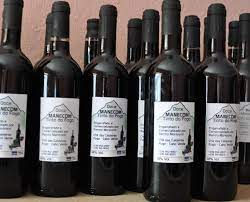Fogo Island
Discovered in 1460 and named São Filipe Island, it was later renamed Fogo Island (or Djarfogo), probably due to the volcano.
It was the second island to be populated in the Cabo Verde archipelago. São Filipe is the third oldest city in the archipelago. Like the other islands, it has a volcanic origin, having the shape of a volcano, which is still active (the last eruption was in 2014) – the volcano rises magnanimously in the heart of the island. Its most extraordinary feature is the 9 km wide crater with a 1 km high rim. The crater has a crack in its eastern wall, and a large peak that rises at its center – Pico do Fogo – which constitutes the highest point on the island (2829 m) and its summit is about 100 m higher than the rim of the crater that surrounds it. The volcano not only dominates Fogo Island, Fogo Island is the volcano.
The black, inhospitable and almost lunar-looking landscape of the Parque Natural do Fogo is a challenge for the senses – a contrast between the wild and the beautiful, between the black and the vividness of the intense blue of the sky.
The volcano is one of the main reasons for the low population density – the rate of emigration is extremely high, with a large community of Cape Verdeans originating on the island of Fogo in the USA.
The island has extremely fertile soils and very favorable to agriculture, since, and unlike other islands, the temperature, air humidity, cloudiness and precipitation are extremely favorable to agricultural activity and production, among the agricultural activities of the present, we highlight the production of coffee and wine, which are important pillars of this activity and with great added value for the economy of the families of this island.
Coffee is essentially produced in Mosteiros (situated in the north of the island) and is a product that is very well-known and valued on the island, it has high quality and aroma.
Gastronomy
The cuisine is fabulous, with great emphasis on fish and seafood – that the generous sea offers.
What to do
You can visit the island in an organized way or make your own itinerary and in this case we recommend the following itinerary:
-
Climb to Pico do Fogo, the top of the Fogo Volcano (to better enjoy this fantastic experience, it is advisable to do it with an accredited guide);
-
Climb to Pico Pequeno;
-
Taking the trail from the caldera to Mosteiros (accompanied by an accredited guide will always be a safer adventure);
-
Visit a winery in Chã das Caldeiras;
-
Sleeping in a private house inside the boiler;
-
Have lunch outdoors inside the volcano's crater
-
Explore the colonial town of São Filipe;
-
Attend a concert by the 7Sóis Popular Orchestra at the Sete Sóis Sete Luas Centrum (in São Filipe).
The island can be visited throughout the year, however the months of July and August are quite rainy, so the best time to visit this island of contrasts is between October and July.



